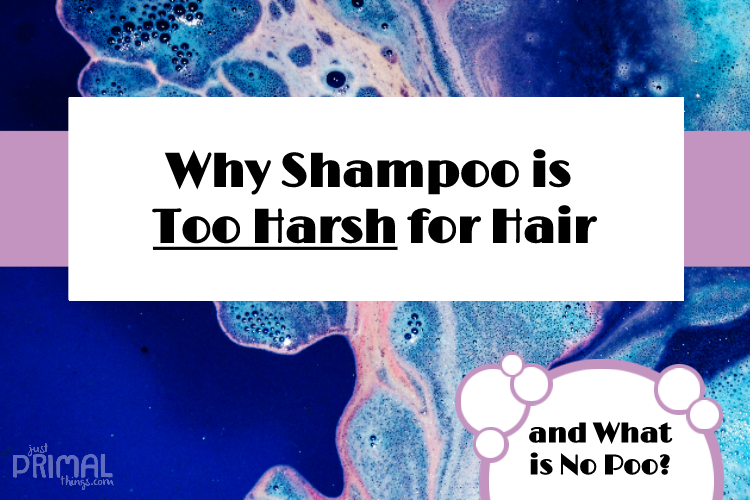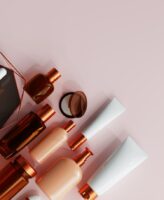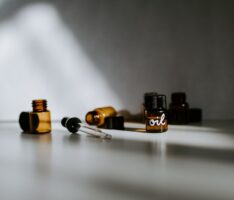
Shampoo ingredients are too harsh for hair
Is shampoo bad for hair? We rely on shampoos to wash away excess oils from our hair and scalp. But many modern commercial shampoos contain overly harsh cleansers that can destroy the quality of hair and make the scalp over-produce oils.
Sulfates are too harsh for hair
A main ingredient commonly found in modern, commercial shampoos is sulfates – and they’re terrible for hair.

Sulfates are the harsh detergents in modern shampoos that create the soapy lathering effect. Instead of just washing away excess oils, sulfates cleanse by stripping the natural oils off the hair and scalp. When stripped of natural oils, hair becomes dry (leading to frizz) and brittle (prone to breakage), and the scalp can become dry, itchy, and kick into overdrive to produce more oils to compensate. Cue the need for more shampoo which dries out the scalp. Cue the scalp overproducing oils to compensate. It’s vicious, greasy cycle of over cleansing, and the quality of our hair can suffer. (More on sulfates here.)
Common ingredient names for sulfates
- Sodium Lauryl Sulfate (SLS)
- Sodium Laureth Sulfate (SLES)
- Sodium Lauryl Sulfoacetate
- Sodium Cocoyl Isoethionate
- Sodium Cocoyl Sarcosinate
- TEA-Dodecylbenzenesulfonate
- Disodium Laureth Sulfosuccinate
- And many more…
Silicones don’t fix hair

But the ridiculous cycle doesn’t end there. Conditioners were put on the market to mask the drying effects of shampoo. Many modern commercial conditioners and styling products contain silicones which give hair a temporary appearance of hydration after the sulfates stripped away natural oils. Silicones mimic the benefits that natural hair oils would actually give hair: Silicones coat the hair, smooth out the cuticle, and give it shiny, “anti-humidity” properties – which many of us desperately need to counteract dryness and frizz after shampoo strips our hair’s natural oils. Silicones sound great, but there are two major problems with silicones:
- Silicones don’t actually hydrate, nourish, or cure dry hair; they just temporarily hide dryness
- The most common silicones are not water-soluble. This means if silicones are not washed out regularly, they can build up on the hair and create a waterproof barrier that prevents hydration from reaching the hair shaft – further making hair dry and prone to breakage.
Silicone buildup can be prevented if silicones are properly and regularly washed out of hair. But here’s the catch – silicones can only be washed out with a harsh sulfate shampoo. *Sigh*…. Rinse and repeat. (More on silicones here.)
Common ingredient names for silicones
- Dimethicone
- Dimethiconol
- Cetyl dimethicone
- Cetearyl methicone
- Stearyl dimethicone
- Cyclomethicone
- Amodimethicone
- And many more… (See #2)
Gosh, this is a lot of work. And we could really get into an entire discussion about how profitable this ridiculous cycle is for the cosmetics industry, but we’ll save that for another day. The point is shampoo may be the cause of the reasons we struggle with our hair, and we need a gentler hair washing method.
Even sulfate-free shampoos can be too harsh for hair

Sulfate-free shampoos have been on the market for years. Many high-end shampoos (used by hair professionals and in salons) didn’t contain sulfates well before the recent wave of brands labeling products as “sulfate-free.”
Switching from a sulfate shampoo to a sulfate-free shampoo will generally be less drying for hair. But some sulfate-free shampoos still contain harsh cleansing ingredients that are very similar to sulfates. Either way, many people still experience negative effects from the overly cleansing ingredients in sulfate-free shampoos.
Shampoo is a modern invention
Humans didn’t start using modern shampoo until the early 1900’s. And it wasn’t until the 1930’s that synthetic cleansers were introduced in shampoos. Before the 1900’s, humans didn’t rely on the harsh cleansers found in modern shampoos to wash their hair. They used natural ingredients and methods to wash away dirt and excess oil. (More about the history of shampoo.)
Hair loves oil…

Beauty gurus with luscious, long hair rave about the effects of regularly adding oil treatments to their hair. These ladies daily or weekly add coconut oil, argan oil, olive oil, (etc.) to their hair. Some would focus oil just on their ends to prevent damage, while others would put it all over their hair and scalp. They enthuse about the hydrating benefits oils would give their hair, leaving it soft, silky, and shiny, better than any commercial product. Their reasoning was that we needed to add oils back into our hair – oils that would otherwise be there naturally – to keep hair healthy, hydrated, and protected from the elements.
The scalp naturally produces oils, which hair loves. When the hair and scalp stop being regularly stripped of natural oils, a few things happen:
- scalp oil production can slow down, and hair can stop looking excessively oily between washes
- hair can absorb its own natural oils, (when not blocked by a silicone product barrier), and any excess natural oils can be washed away with a gentle cleanser.
- When the hair’s natural oils absorb into hair, it can provide hydration, promote elasticity, and counteract tangles, so hair is able to be shiny, strong, frizz-free, and manageable.
Sounds like a shampoo advert – you know, the ones that never deliver on their promises… except the hair’s natural oils were designed by nature to do all of this for free.
Gentler ways to wash hair

There are gentle and inexpensive hair washing methods that provide clean results without stripping away natural oils. These gentler methods wash away only the excess oils, and they don’t trigger the scalp into overproducing a ridiculous amount of oils between washes.
The No-Shampoo (No Poo) Movement
There’s an entire movement of people supporting shampoo-free hair care, called the “No Poo” movement, and sharing personal accounts of their success. (Including myself!) Many people who switch from shampoo to natural cleaners get the same results after a while: soft, silky, clean hair, with volume, increased manageability, less oil production, and more defined curls & waves. The pictures of their awesome looking hair is pretty eye opening!
This blog covers detailed information about No-Shampoo or “No Poo” hair washing methods, including how to get started, various methods, tips and techniques, and FAQs. (Beginners start here.)



